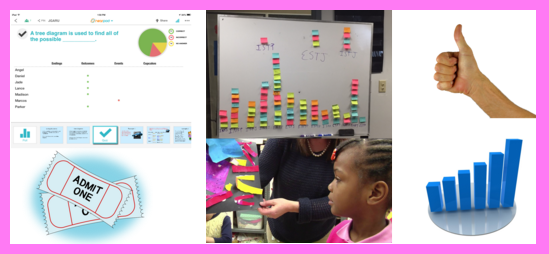


- Go-around
- Teachers call on students in rapid succession to answer prompts with 1-2 word responses
- Whiteboards
- Students write responses on white boards and hold up boards for teacher and peer scanning.
- Do now
- A brief problem or task that students complete to show they are ready for the next part of the lesson
- Clicker checks
- Use technology to gather student responses and display them in graphics on the board.
- Related tools: Kahoot, Nearpod, Secretive, Mentimeter
- Explain It
- Teachers check for misconceptions by having students explain instructions for an activity to a peer or to the teacher
- Table tags
- Students choose to sit at labeled tables with symbols that represent different readiness levels.
- Thumbometer or First to Five
- Students can show confidence (or lack of) for a task by raising thumbs up, to the side or down or by showing number of fingers that corresponds to their level of confidence
- Glass, bugs, mud
- Students label their understanding of concepts using glass (totally clear concepts), bugs (little fuzzy concepts), and mud (don’t understand or see concept)
- Sticky bars
- Create a chart that shows levels of understanding. Students post their name on a sticky note on the region that represents their levels of understanding.
- Learning Lineups
- Students line themselves up on a continuum to represent their level of understanding of knowledge from novice to expert. Also see Where do you stand?.
- Human bar graph
- Label 4 lines by different levels of understandings. Students form a human bar graph by standing on the line that represents their level of understanding.
- Scatterplot graph
- Similar to human bar graph except represents level of understanding to a specific concept or problem.
- Hot seat
- Students answer reflection questions placed on their hot seats. Students not at hot seats agree or disagree with students’ responses.
- Admission and exit tickets
- Students indicate readiness for next activity by answering questions (1 or 2) on small slips of paper. For more info, go here.
- Presentation assessments
- Students present information and use methods to determine whether or not other students understood what they presented.

Quick checks for understanding can help teachers see whether or not students are ready to move unto to new lessons. These quick types of assessments gives teachers quick snapshots of student learning that can help teachers adjust lesson pacing and questions in real time.

Preparation Steps
- In a scaffolding lesson, identify points when it will be good to check for student understanding.
- Determine the quick checks that can quickly you can you best snapshot of student learning that can let you know if students are ready to move on or need more time and/or explanations.
Early Implementation Steps
- Implement quick checks periodically during scaffolding lessons to direct students to process their learning and communicate their readiness levels.
- Adjust pacing and levels of attention to specific students based on the data you get from quick checks.
Advanced Implementation Steps
- Have pre-prepared activities (multiple advance points) that go with different readiness levels that emerge from quick checks.
